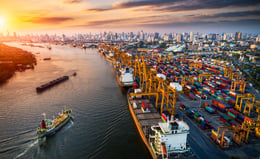Resolve Rhine River Shipping Challenges in 4 Easy Steps
Keith LaBotz - September 01, 2022

The Rhine river is drying up and taking a vital transportation network with it. What can supply chains do to avoid going down with the Rhine?
Despite dominating headlines, Rhine River shipping disruptions from low waters are nothing new. What is new this time around are innovative solutions that can help shippers and transportation carriers resolve Rhine shipping challenges.
The current Rhine river shipping crisis joins ocean port congestion, truck driver shortages, and lockdowns constricting transportation capacity in the global supply chain. Adding fuel to a more extensive supply chain wildfire has increased the stakes this time around:
- According to Albert Jan Swart, a transportation economist at ABN Amro Bank NV, regional Rhine economies are expected to lose more than five billion euros ($5.1 billion) lost in 2018 from low water levels.
- Germany’s plan to fire up mothballed coal power plants to offset fuel losses from sanctions increases supply chain risks and carbon emissions. Deutsche Bank economists note that "hard-coal is transported from the Dutch ports of Amsterdam, Rotterdam, and Antwerp by barges." Power plants compete for cargo capacity against factories that need electricity.
- There are no viable transportation alternatives for river freight. According to the German Federal Institute of Hydrology, shipping from Rotterdam to Basel costs around 40% less than rail transport. A ship carrying 1,000 tons of wheat requires about 40 trucks to haul the same quantity over the road at a significantly higher cost. Even if shippers were prepared to pay the premium, trucking and rail capacity are insufficient for handling river freight volumes.
The importance of these solutions cannot be overstated. Transportation is the core of every supply chain, placing Rhine River shipping at the center of Europe’s economies. Companies that make process improvements will also contribute to improving the entire Rhine River transportation network:
- More diesel, coal, and other cargo can be delivered to energy and industrial production to prevent disruptions.
- Transportation resources can be fully utilized, reducing transportation costs.
- Traffic flowing into North Sea ports and the Black Sea is stabilized, strengthening Europe’s connection to global markets.
The good news is that supply chains have gained unprecedented experience resolving similar challenges over the past two years, and solutions have never been so abundant. Read on to learn four steps your company can take to resolve Rhine River shipping challenges.
1. Plan on Transportation Volatility
The problem Rhine supply chains face is not low water but the inability to quickly adapt to transportation volatility. Increasing agility requires a process that assumes transportation volatility.
Without needed process improvements to transportation planning and execution, supply chains remain vulnerable to the whims of Mother Nature, and the consequences can be severe:
- “After a record dry summer in Germany, it’s impossible to predict how long the crisis will continue. Rain can lead to an increase in the water level, but only incrementally... it would likely be weeks before shipping can be fully resumed on Germany’s major shipping lanes. And things could get worse before they get better… “
-
The chemical industry and the world are anxiously waiting to see what the impact of the extreme drought coupled with possible new tariffs, trade agreements, and regulatory changes resulting from the U.S. mid-term elections will have on the industry, supply chains, and the global economy. At this time—the outlook is grim.”
-
“A heatwave in Europe is causing low water levels on the River Rhine — one of the continent’s most important shipping routes — which could weigh further on Germany’s vulnerable economy, experts have told CNBC.”
The first quote is from April 10, 2003, DW article warning of a bleak economic consequence of the Rhine’s low water levels. The second was issued 15 years later, in 2018, and the third in 2019. In a recent report, Andrew Kenningham, chief Europe economist at Capital Economics, pointed out that Rhine shipping has shut down nine times since 1990.
Regardless of climate model predictions, history shows Rhine shipping disruption is inevitable. Businesses must assume carrier capacity is highly variable and monitor water levels as the key indicator.
2. Incorporate Water Levels into Planning
Incorporating river levels, carrier capacity, and weather forecasts into the transportation planning process allow crucial what-if analysis. This expands contingencies and the potential for collaborative problem-solving with external carriers.
-
Most of the low-water problems are concentrated in Germany. Holland can better maintain water levels for its domestic shipping traffic due to its extensive network of inland canals.
-
The water level at one bottleneck near the town of Kaub on the Middle Rhine indicates capacity. When water levels hit 40 cm, river transport is no longer economical, and a reading below 30 cm (11.8 inches) is considered unpassable. Kaub hit 32 cm on August 15 and rises again from recent rainfall but may drop again.
-
Some climate models predict sustained droughts for Europe; if these prove correct, transportation capacity will decrease. Wilfried Hagg, a glacier expert at Munich University, told Bloomberg, "A warming climate means that incidents like the low river levels this summer are more likely to occur." Regardless of how models pan out, Rhine shipping disruption is a recurring problem expected to continue, as noted previously.
3. Support Dynamic Shipping Costs
For shippers, securing transportation is the crux of the Rhine River shipping crisis, and transportation pricing plays an integral role. While shippers prefer the simplicity of stable pricing contracts, it puts carriers at risk when conditions are volatile. The solution is dynamic pricing that closely aligns transportation prices with each carrier’s costs.
As supply chain digitalization progresses, carriers are more likely to favor shippers that support dynamic pricing, such as spot markets. Shipper transportation planning systems must integrate with carrier pricing systems, online freight brokers, and market intermediaries.
4. Optimize the Enterprise Around Transportation
The best outcome for a shipper or carrier occurs if planning and execution are optimized across the entire enterprise. Reacting to volatility by making decisions based on the immediate impact on shipping can lead to less desirable outcomes for other parts of the enterprise.
Gaining this level of intelligence requires integrating production, S&OP, and shipping operations into a single planning process. A few companies like flexis AG offer products designed for this purpose, and it can allow Rhine shippers and carriers to do the following:
- Optimize production and shipping plans around weather forecasts, water levels, projected river traffic, changing barge rates, and current limits for barge loads.
- See the financial impact of delaying, reducing, or doubling shipping and production with varying water levels.
- Assess the impact of using rail or truck as an alternative to river barges.
Conclusion
The four steps outlined in this article provide shippers and carriers with a simple path forward for resolving Rhine shipping disruptions. flexis AG offers the software and services required to help Rhine shippers and carriers implement the solution discussed.
INTERESTED IN MORE INFORMATION?
LATEST POSTS
- Understand Why Production Planning Needs Specialized Solutions
- Understand Circular Economy in The Manufacturing Industry
- How Can Industry 4.0 IT Integration Be Achieved Smoothly?
- The Significance of Order Sequencing in Discrete Manufacturing
- How to improve your Supply Chain Management: The Power of Control Towers



